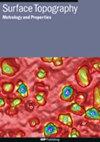Investigation of tribological performance of hydrothermal carbon by pin-on-disc test and warm deep drawing process
IF 2
3区 材料科学
Q2 ENGINEERING, MECHANICAL
引用次数: 0
Abstract
In this study, the synthesis of hydrothermal carbon (HTC) lubricant and its usability as a lubricant under hot industrial conditions were investigated. In this context, the characterization of HTC produced from organic sources at low cost and in a short time was performed, and its tribological performance was analysed in detail. HTC produced by the hydrothermal carbonization method was characterized through SEM images and EDS analysis. To determine the effect of HTC on friction at different temperatures, HTC was subjected to a pin-on-disc wear test with AA5754 material. The effect of various lubricants, temperatures, blank holder pressure, and forming speed parameters on the forming force for the analysis of the tribological effect of HTC on deep drawing processes were statistically analysed. The performance of HTC was compared with Teflon, fullerenes, graphene, and carbon nanotube (CNT) materials. According to the results obtained from wear tests, the lowest friction coefficient value was achieved in the presence of fullerenes as the lubricant, and as the temperature increased, the friction coefficient decreased. It was observed that HTC exhibited lower performance in the wear test compared to fullerenes due to oxidation. When the effect of deep drawing parameters on the forming force was analysed, it was concluded that the most effective parameters were temperature (72.32%) and lubricant (20.89%). According to the S/N analysis results, the minimum forming force was obtained under the conditions of solid Teflon lubricant, 250 °C temperature, 15-bar blank holder pressure, and 2 mm/s forming speed. The tribological performance difference between HTC and Teflon is at the 1% level. The results demonstrate the potential industrial usability of HTC as a lubricant.通过针盘试验和热深拉工艺研究热液碳的摩擦学性能
本研究调查了热液碳(HTC)润滑剂的合成及其在高温工业条件下作为润滑剂的可用性。在此背景下,研究人员对低成本、短时间内从有机来源生产的 HTC 进行了表征,并详细分析了其摩擦学性能。通过 SEM 图像和 EDS 分析,对水热碳化法生产的 HTC 进行了表征。为了确定 HTC 在不同温度下对摩擦的影响,对 HTC 与 AA5754 材料进行了针盘磨损试验。对各种润滑剂、温度、坯料夹持压力和成形速度参数对成形力的影响进行了统计分析,以分析 HTC 对深拉工艺的摩擦学影响。将 HTC 的性能与聚四氟乙烯、富勒烯、石墨烯和碳纳米管 (CNT) 材料进行了比较。根据磨损试验得出的结果,富勒烯作为润滑剂时的摩擦系数值最低,随着温度的升高,摩擦系数下降。据观察,与富勒烯相比,HTC 在磨损测试中由于氧化而表现出较低的性能。在分析拉深参数对成形力的影响时,得出的结论是最有效的参数是温度(72.32%)和润滑剂(20.89%)。根据 S/N 分析结果,在固体聚四氟乙烯润滑剂、温度为 250 ℃、坯料夹具压力为 15 巴、成形速度为 2 mm/s 的条件下,成形力最小。HTC 和聚四氟乙烯之间的摩擦学性能差异达到了 1%。这些结果证明了 HTC 作为润滑剂的潜在工业可用性。
本文章由计算机程序翻译,如有差异,请以英文原文为准。
求助全文
约1分钟内获得全文
求助全文
来源期刊

Surface Topography: Metrology and Properties
Materials Science-Materials Chemistry
CiteScore
4.10
自引率
22.20%
发文量
183
期刊介绍:
An international forum for academics, industrialists and engineers to publish the latest research in surface topography measurement and characterisation, instrumentation development and the properties of surfaces.
 求助内容:
求助内容: 应助结果提醒方式:
应助结果提醒方式:


